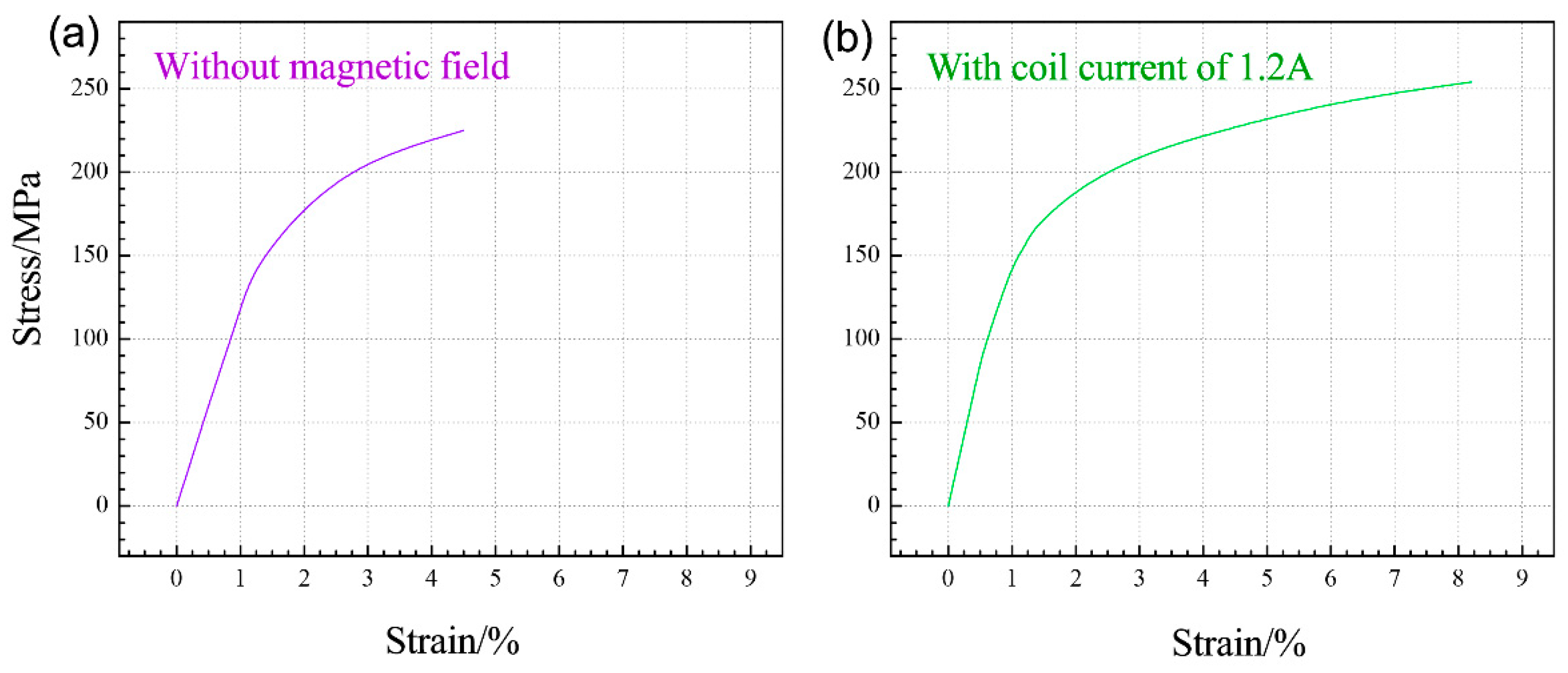The Influence and Mechanism Analysis of the Longitudinal Magnetic Field on the Microstructure Evolution and Properties of AZ40 Welds
Abstract
:1. Introduction
2. Materials and Methods
3. Results and Discussion
3.1. Microscopic Characteristics of Weld
3.2. Hardness Analysis
3.3. Tensile Strength and Fracture Features
3.4. Mechanism of LMF-Assisted Welding
4. Conclusions
- With a magnetic field current of 1.2 A, the average crystallite dimension of the weld seam of the joint decreased from an initial state of 43 μm to 26 μm, indicating that the LMF auxiliary welding process had an obvious grain refinement effect.
- The magnetic field-assisted process not only enhanced the microhardness of the weld seam but also reduced the fluctuation in the hardness value of the weld seam.
- With a magnetic field current of 1.2 A, the joint strength reached 254 MPa, which was 12.9% higher than that of the AZ40 joint without LMF assistance.
Funding
Data Availability Statement
Conflicts of Interest
References
- Yang, J.; Su, J.H.; Yu, Z.S.; Zhang, G.Z.; Lin, S.B.; Li, Y.L.; Zhou, N.Y. Influence of Ni interlayer width on interfacial re-actions and mechanical properties in laser welding/brazing of Al/Mg lap joint. Sci. Technol. Weld. Join. 2020, 25, 37–44. [Google Scholar] [CrossRef]
- Xu, C.; Yuan, X.J. Effect of ultrasonic field parameters on interfacial characteristics and mechanical properties of Mg alloy welding joint. Mater. Lett. 2022, 306, 130962. [Google Scholar] [CrossRef]
- Xiong, Y.; Jiang, Y. Compressive deformation of rolled AZ80 magnesium alloy along different material orientations. J. Mater. Sci. 2020, 55, 4043–4053. [Google Scholar] [CrossRef]
- Xu, C.; Yuan, X.J. The study of microstructure, corrosion resistance and mechanical properties of ultrasonic assisted welding-brazing of Ti-Mg. J. Mater. Res. Technol. 2022, 17, 467–477. [Google Scholar] [CrossRef]
- Feng, M.N.; Luo, Z. Interface morphology and microstructure of high-power ultrasonic spot welded Mg/Al dissimilar joint. Sci. Technol. Weld. Join. 2019, 24, 63–78. [Google Scholar] [CrossRef]
- Lei, Z.; Bi, J.; Li, P.; Li, Q.; Chen, Y.B.; Zhang, D.M. Melt flow and grain refining in ultrasonic vibration assisted laser welding process of AZ31B magnesium alloy. Opt. Laser Technol. 2018, 108, 409–417. [Google Scholar] [CrossRef]
- Li, G.; Zhou, L.; Luo, S.; Dong, F.; Guo, N. Quality improvement of bobbin tool friction stir welds in Mg-Zn-Zr alloy by adjusting tool geometry. J. Mater. Process. Technol. 2020, 282, 116685. [Google Scholar] [CrossRef]
- Xu, C.; Sheng, G.M.; Wang, H.D.; Jiao, Y.J.; Yuan, X.J. Effect of high energy shot peening on the microstructure and me-chanical properties of Mg/Ti joints. J. Alloys Compd. 2017, 695, 1383–1391. [Google Scholar] [CrossRef]
- Zhang, G.Q.; Tong, X.; Wu, G.H.; Zhang, L.; Sui, H.; Zhang, X. Research on the post-weld heat treatment of TIG repair welded joint of sand-cast Mg-Y-RE-Zr alloy. Mater. Sci. Eng. A 2021, 821, 141577. [Google Scholar] [CrossRef]
- Tang, J.W.; Chen, L.; Zhao, G.Q.; Zhang, C.; Chu, X. Formation mechanism of abnormal coarse grains on weld seam of extruded ZK60 alloy and the effects on mechanical properties. Mater. Sci. Eng. A 2020, 773, 138718. [Google Scholar] [CrossRef]
- Wang, J.F.; Sun, Q.; Zhang, T.; Zhang, S.; Liu, Y.; Feng, J. Arc characteristics in alternating magnetic field assisted narrow gap pulsed GTAW. J. Mater. Process. Technol. 2018, 254, 254–264. [Google Scholar] [CrossRef]
- Li, Y.; Luo, Z.; Yan, F.Y.; Duan, R.; Yao, Q. Effect of external magnetic field on resistance spot welds of aluminum alloy. Mater. Des. 2014, 56, 1025–1033. [Google Scholar] [CrossRef]
- Li, Y.B.; Zhang, Q.X.; Qi, L.; David, S.A. Improving austenitic stainless steel resistance spot weld quality using external magnetic field. Sci. Technol. Weld. Join. 2018, 23, 619–627. [Google Scholar] [CrossRef]
- Pereira, D.; Oliveira, J.P.; Pardal, T.; Miranda, R.M.; Santos, T.G. Magnetic pulse welding: Machine optimisation for aluminium tubular joints production. Sci. Technol. Weld. Join. 2017, 23, 172–179. [Google Scholar] [CrossRef]
- Liu, Y.B.; Sun, Q.J.; Liu, J.P.; Wang, S.; Feng, J. Effect of axial external magnetic field on cold metal transfer welds of aluminum alloy and stainless steel. Mater. Lett. 2015, 152, 29–31. [Google Scholar] [CrossRef]
- Sun, Q.; Li, J.; Liu, Y.; Li, B.; Xu, P.; Feng, J. Microstructural characterization and mechanical properties of Al/Ti joint welded by CMT method—Assisted hybrid magnetic field. Mater. Des. 2017, 116, 316–324. [Google Scholar] [CrossRef]










| Element | Zn | Mn | Fe | Al | Mg |
|---|---|---|---|---|---|
| AZ40 | 0.8 | 0.3 | 0.02 | 4.2 | Bal. |
| Parameter | Value |
|---|---|
| Welding current/A | 80 |
| Welding voltage/V | 12 |
| Arc length/mm | 2 |
| Argon flow rate/(L·min−1) | 10 |
| Coil current/A | 0.3–1.5 |
| Sample | Base Metal | AZ40 Joint (0A) | AZ40 Joint (0.3A) | AZ40 Joint (0.6A) | AZ40 Joint (0.9A) | AZ40 Joint (1.2 A) | AZ40 Joint (1.5A) |
|---|---|---|---|---|---|---|---|
| Average grain size (μm) | 14 | 43 | 41 | 37 | 32 | 26 | 30 |
Disclaimer/Publisher’s Note: The statements, opinions and data contained in all publications are solely those of the individual author(s) and contributor(s) and not of MDPI and/or the editor(s). MDPI and/or the editor(s) disclaim responsibility for any injury to people or property resulting from any ideas, methods, instructions or products referred to in the content. |
© 2024 by the author. Licensee MDPI, Basel, Switzerland. This article is an open access article distributed under the terms and conditions of the Creative Commons Attribution (CC BY) license (https://creativecommons.org/licenses/by/4.0/).
Share and Cite
Wang, J. The Influence and Mechanism Analysis of the Longitudinal Magnetic Field on the Microstructure Evolution and Properties of AZ40 Welds. Crystals 2024, 14, 449. https://doi.org/10.3390/cryst14050449
Wang J. The Influence and Mechanism Analysis of the Longitudinal Magnetic Field on the Microstructure Evolution and Properties of AZ40 Welds. Crystals. 2024; 14(5):449. https://doi.org/10.3390/cryst14050449
Chicago/Turabian StyleWang, Jianghui. 2024. "The Influence and Mechanism Analysis of the Longitudinal Magnetic Field on the Microstructure Evolution and Properties of AZ40 Welds" Crystals 14, no. 5: 449. https://doi.org/10.3390/cryst14050449






